Steps to take when the person you are concerned about is at the workplace
A person who has recently been at your workplace such as a worker, client or customer may inform you they have, or may potentially have, COVID-19. Depending on the circumstances (e.g. how recently the person was at your workplace and how closely they were in contact with others) you may have reasonable concerns about the health of others in your workplace.
You must continue to meet your WHS duties at all times. This may mean taking steps above and beyond public health requirements to eliminate or minimise, so far as is reasonably practicable, the risk of workers and others in your workplace (such as customers) contracting COVID-19.
Step 1. Seek advise and assess the risks
To determine if it is reasonable to suspect the person may have COVID-19, talk to the person about your concerns and see what they say. You do not have to do this if the person has already informed you that they have or may potentially have COVID-19
Seek government health advice by calling your state or territory helpline. Follow the advice of your state and territory public health unit. You can also contact the National Coronavirus Helpline on 1800 020 080, which operates 24 hours a day, seven days a week. The National Helpline can provide advice on when and how to seek medical help or about how to get tested for COVID-19.
Ensure that you have current contact details for the person and make a note about the areas they had been in the workplace, who they had been in close contact with in the workplace and for how long. This will inform you about risks to others and areas to clean and disinfect. This information may also assist your state and territory public health unit if they need to follow up with you at a later time.
Your state or territory WHS regulator may also be able to provide specific WHS advice on your situation.

Step 2. Identify and tell close contacts
The state or territory public health unit will identify close contacts of a confirmed COVID-19 case and provide them with instructions, for example, in relation to quarantine requirements.
In the meantime, for the purposes of undertaking a workplace risk assessment and to assist your state and territory public health unit, consider who the affected person may have had recent close contact with. If instructed by health officials, tell close contacts that they may have been exposed to COVID-19 and the requirements for quarantine. You must maintain the privacy of all individuals involved.
Seek information about the areas that close contacts have been in the workplace, who they have been in close contact with in the workplace and for how long. This will inform you about possible risks to others, and additional areas that may also need to be cleaned and disinfected.
Step 3. Clean and disinfect
Close off the affected areas and do not let others use or enter them until they have been cleaned and disinfected. Open outside doors and windows if possible to increase air flow.
All areas, for example offices, bathrooms, kitchens and common areas as well as equipment or PPE that were used by the person concerned must then be thoroughly cleaned and disinfected.
Cleaners must wear appropriate PPE, for example disposable gloves or gloves appropriate to the cleaning chemicals being used, and safety eyewear to protect against chemical splashes. If there is visible contamination with respiratory secretions or other body fluids in the area, the cleaners should also wear a disposable apron.
Your state and territory public health unit may also provide you with further information about how and where to clean. You must follow those instructions.

Step 4. Review risk management controls
Review your COVID-19 risk management controls, in consultation with your workers and their representatives, and assess and decide whether any changes or additional control measures are required.
You must continue to meet your WHS duties at all times. This may mean taking steps above and beyond public health requirements to eliminate or minimise, so far as is reasonably practicable, the risk of workers and others in the workplace (such as customers) contracting COVID-19.
